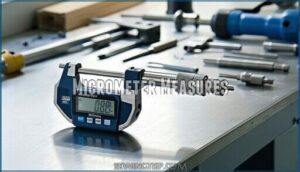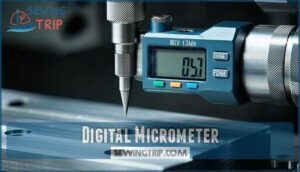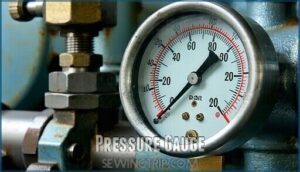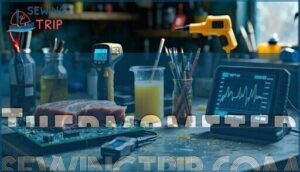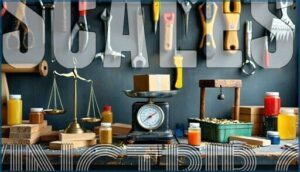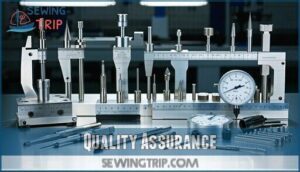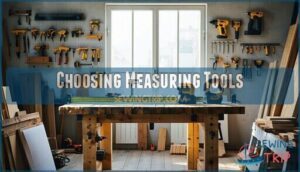This site is supported by our readers. We may earn a commission, at no cost to you, if you purchase through links.
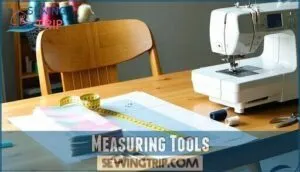
Essential measuring tools include tape measures for basic dimensions, digital calipers for precise measurements down to thousandths of an inch, levels for perfect alignment, and angle finders for accurate cuts.
Speed squares help with quick calculations, while contour gauges capture irregular shapes perfectly.
Digital tools have revolutionized home workshops, offering LCD displays and instant readings that eliminate guesswork.
Whether you’re hanging pictures or building cabinets, these tools guarantee your measurements are spot-on every time, preventing costly mistakes and material waste that can derail any project.
Table Of Contents
- Key Takeaways
- Measuring Tools Basics
- Top 10 Measuring Tools
- 1. Digital Caliper Measuring Tool 6 Inch
- 2. Digital Caliper Stainless Steel Measuring Tool
- 3. Digital Caliper Electronic Measuring Tool
- 4. Sangabery Digital Caliper 0-6 Inches
- 5. Saker 10 Inch Contour Gauge
- 6. Swanson 7 Inch Blue Speed Square
- 7. Digital Angle Finder Protractor Ruler
- 8. General Tools 6 Inch Steel Ruler
- 9. Klein Tools Digital Level Angle Gauge
- 10. Esydon Digital Caliper Measuring Tool
- Precision Measuring Tools
- Measuring Tools Applications
- Choosing Measuring Tools
- Frequently Asked Questions (FAQs)
- Conclusion
Key Takeaways
- You’ll need digital calipers for precise measurements down to thousandths of an inch, eliminating guesswork in critical dimensions and ensuring professional-quality results in your DIY projects.
- You should invest in speed squares and angle finders to achieve accurate cuts and perfect alignments, preventing costly mistakes that can derail your entire project timeline.
- You can’t overlook specialized tools like contour gauges for irregular shapes and levels for horizontal alignment, as these instruments handle tasks that basic measuring tools simply can’t accomplish.
- You must calibrate your measuring tools regularly—precision instruments monthly, standard tools quarterly—to maintain accuracy and prevent measurement errors that waste materials and compromise your work quality.
Measuring Tools Basics
You’ll need the right measuring tools to guarantee accuracy and professional results in your DIY projects.
Understanding the three main categories of measuring tools—angle and inclination, dimension and distance, and level and alignment—helps you choose the correct instrument for each specific task.
Angle and Inclination Measuring Tools
When working on DIY projects, you’ll need precise angle measurements to guarantee professional results.
Angle locators with magnetic bases attach to metal surfaces for convenient measurement from 0° to 90°.
These essential tools help you achieve accuracy:
- Angle locator – measures basic angles with magnetic attachment
- Bubble inclinometer – tracks joint motion and grade stability
- Digital angle gauge – provides quick, calibrated readings
- Bevel protractors – offer advanced precision with swinging arms
For pattern drafting, consider using L-squares for accuracy when creating precise 90-degree angles.
Dimension and Distance Measuring Tools
When measuring distances becomes your priority, you’ll need reliable dimension and distance tools.
Calipers offer exceptional caliper accuracy for precise thickness measurements, while tape measures use durable tape measure materials for flexible measuring up to 100 feet.
Rulers provide ruler precision for straight-line work, and odometers require proper odometer calibration for accurate distance tracking.
Roll meter uses include furniture applications, making these tools indispensable for any project that requires precise thickness measurements.
Level and Alignment Measuring Tools
When your level accuracy matters most, these tools keep your DIY projects straight and square.
A spirit level uses air bubbles to establish true horizontal planes, while laser technology projects precise beams for alignment.
Digital angle gauges and angle locators provide exact measurements, and bubble inclinometers track joint movement and grade stability.
- Level accuracy guarantees your shelves won’t become slides for your coffee mug
- Laser level technology eliminates guesswork with bright, visible reference lines
- Spirit level types include line, frame, and digital versions for different applications
- Compass navigation relies on Earth’s magnetic field for consistent directional reference
Top 10 Measuring Tools
You’ll discover the most effective measuring tools that transform your DIY projects from guesswork into precision craftsmanship.
These ten essential instruments provide the accuracy and reliability you need to tackle everything from basic home repairs to complex woodworking tasks, allowing for effective measuring.
1. Digital Caliper Measuring Tool 6 Inch
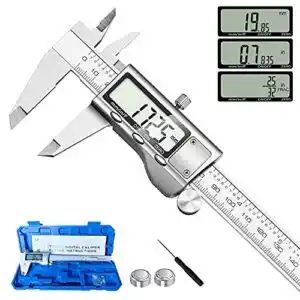
Every professional craftsperson knows that precision starts with the right tools.
Professional craftspeople understand that accuracy begins with quality measuring tools.
The 6-inch digital caliper delivers ±0.001 inch accuracy across four measurement modes: inside diameter, outside diameter, depth, and step measurements.
You’ll appreciate its stainless steel construction and waterproof design that withstands shop conditions.
The large LCD display switches between inches, fractions, and millimeters instantly, while auto-off functionality conserves battery life during extended projects.
Best For: Hobbyists, woodworkers, mechanics, and professionals needing reliable, versatile, and accurate measurement in daily projects.
- Plastic case hinge is fragile and may break with frequent use.
- Slight play in the thumb wheel can affect precision.
- Not intended for high-end scientific or industrial use.
- Durable stainless steel construction with waterproof and dustproof protection.
- Accurate measurements in four modes, with quick unit conversion and easy-to-read LCD.
- Auto-off feature extends battery life and includes extra batteries and a storage case.
2. Digital Caliper Stainless Steel Measuring Tool
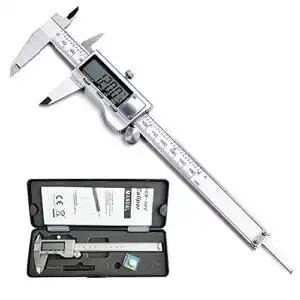
Stainless steel construction sets these calipers apart from plastic alternatives you’ll encounter.
You’ll get hardened steel jaws that resist flex and maintain accuracy under repeated use, with a polished finish preventing corrosion during extended shop work.
The durable build meets DIN 862 standards for industrial tolerances, while the reinforced design delivers consistent ±0.02mm precision across internal, external, step, and depth measurements for demanding applications.
Best For: Professionals and DIYers needing accurate, durable digital calipers for precise metalworking, woodworking, or quality control.
- Maximum range limited to 6 inches, which may not suit larger projects
- Does not display fractional measurements (decimal only)
- Requires careful handling to maintain precision and avoid calibration drift
- Hardened stainless steel construction ensures long-term durability and corrosion resistance
- Maintains ±0.02mm accuracy for internal, external, step, and depth measurements
- Easy-to-read LCD display with instant inch/mm conversion and simple zeroing
3. Digital Caliper Electronic Measuring Tool
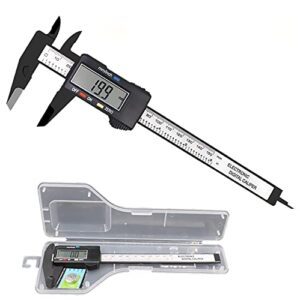
Precision reaches new heights when electronic technology meets traditional measuring needs.
You’ll find digital caliper electronic measuring tools deliver ±0.02mm accuracy with 0.01mm resolution across their standard 0-150mm range.
These versatile instruments handle external, internal, depth, and step measurements while featuring LCD displays, inch/millimeter conversion, and auto-shutoff functions.
Their hardened stainless steel jaws resist wear, while ergonomic designs support single-hand operation for efficiency in workshops, laboratories, and quality control applications, ensuring high efficiency and precision.
Best For: DIY hobbyists, students, and occasional users needing accurate digital measurements for home projects, crafts, or educational tasks.
- Easy-to-read LCD with quick unit conversion and zero reset for versatile measurement tasks
- Lightweight design with smooth sliding action and included extras like batteries and storage case
- Accurate enough for most household and hobby needs, providing good value for the price
- Not recommended for industrial or high-precision professional applications
- Plastic parts may be less durable than full metal alternatives
- Mixed feedback on long-term build quality and precision compared to premium models
4. Sangabery Digital Caliper 0-6 Inches
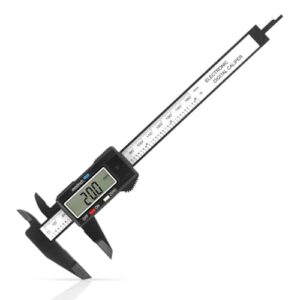
You’ll find the Sangabery Digital Caliper delivers reliable measurements at an unbeatable price point.
This lightweight carbon fiber composite tool offers ±0.01 inch accuracy across its 6-inch range, making it perfect for woodworking, jewelry work, and automotive projects.
The large LCD display switches between inches and millimeters instantly, while the auto-off function conserves battery life.
With over 10,000 positive reviews and beginner-friendly operation, it’s earned its spot among 2024’s top-selling digital calipers for hobbyists.
Best For: Hobbyists, DIYers, and students needing affordable, easy measurements for home and light workshop tasks.
- Plastic build is less durable than stainless steel options
- Not suitable for heavy-duty or high-precision professional work
- Occasional user reports of missing or faulty components upon delivery
- Lightweight carbon fiber construction is portable and rust-resistant
- Large LCD is easy to read and unit conversion is fast
- Offers good accuracy and value for general-purpose use
5. Saker 10 Inch Contour Gauge
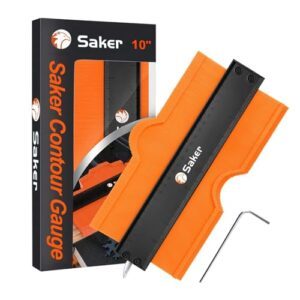
When tackling irregular shapes in your DIY projects, you’ll discover the Saker 10 Inch Contour Gauge transforms complex measurements into simple transfers.
This ABS plastic tool features over 100 precision teeth that conform to any surface contour, from curved moldings to pipes.
You’ll appreciate its dual locking mechanism that holds shapes perfectly during transfer, ensuring accurate cuts every time.
With 0.05-inch tooth spacing, it captures fine details other gauges miss, making it essential for woodworking, tile installation, and flooring projects where precision matters most.
Best For: DIYers, carpenters, and hobbyists who need precise shape duplication for woodworking, flooring, and custom fitting projects.
- Accurate contour replication with 0.05-inch tooth spacing and dual locking mechanism.
- Durable, lightweight ABS plastic build with over 100 fine-resolution teeth for detailed profiles.
- Easy to use on a range of materials and ideal for complex cuts in tight spaces.
- Not recommended for heavy-duty, professional use due to quality limitations.
- Included hex key for adjusting tightness is easily misplaced and not securely housed.
- Requires careful handling to prevent wear or damage to contour teeth.
6. Swanson 7 Inch Blue Speed Square
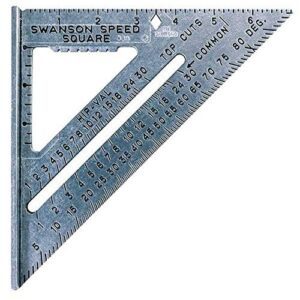
When you need a speed square that can handle years of job site abuse, the Swanson 7 Inch Blue Speed Square delivers professional-grade performance.
This heavy-gauge aluminum tool combines five essential functions: try square, miter square, saw guide, line scriber, and protractor.
Its laser-etched gradations won’t fade over time, while the blue anodized finish resists corrosion and improves visibility.
You’ll appreciate the precision-machined heel that fits snugly against lumber and the integrated rafter tables that eliminate guesswork in roof framing projects.
Best For: Pros, hobbyists, and DIYers who need a reliable, all-in-one tool for carpentry, framing, and roofing.
- Combines five essential tools into one for fast, accurate measurements and cuts.
- Heavy-gauge, rust-resistant aluminum with deeply etched markings for long-lasting durability.
- Easy-to-read, high-contrast gradations and rafter tables increase speed and precision for common cuts.
- Only accommodates imperial measurements, which limits use for metric projects.
- Pocket-sized, but may feel small for larger lumber or framing tasks.
- Blue anodized finish can show wear after heavy, prolonged use.
7. Digital Angle Finder Protractor Ruler
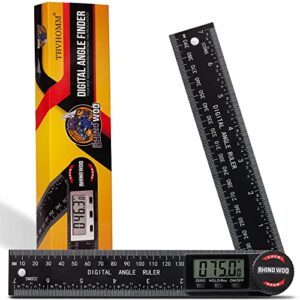
You’ll master complex angles with this 2-in-1 digital protractor that combines precision measuring with practical versatility.
The TBVHOMM angle finder delivers ±0.3° accuracy across a 999.9° range, featuring a clear LCD display and essential functions like hold, zero, and lock.
Its enhanced ABS construction withstands job site demands while measuring both internal and external angles.
Whether you’re setting miter saw blades, checking wall corners, or replicating parts for 3D printing, this tool handles woodworking and construction tasks with reliable consistency and user-friendly operation, making it a valuable asset for precise angle measurement with practical versatility.
Best For: Woodworkers, architects, and DIYers who need accurate, quick angle measurements for projects like cutting, construction, or 3D replication.
- Lock knob can be sensitive and may shift angle if bumped
- Occasional inconsistent readings reported by users
- Battery replacement may be needed over time
- High accuracy (±0.3°) and large measuring range (up to 999.9°)
- Clear LCD with backlight and multiple functions (hold, zero, lock, reverse angle)
- Rugged ABS build and includes spare battery for long-term use
8. General Tools 6 Inch Steel Ruler
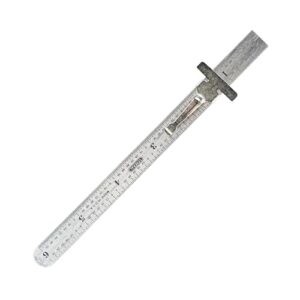
Every serious DIYer knows that precision starts with the basics, and the General Tools 6 Inch Steel Ruler delivers exactly that foundation.
This hardened stainless steel ruler features laser-etched graduations in 32nds, 64ths, and decimal equivalents, maintaining ±0.002 inch accuracy that won’t fade over time.
You’ll appreciate its satin chrome finish that reduces glare while the acid-etched markings resist wear from repeated use.
Whether you’re setting up reference measurements or working in tight spaces, this pocket-sized powerhouse proves that sometimes the simplest tools are the most indispensable.
Best For: DIYers, hobbyists, and professionals who demand long-lasting precision for measuring and calibration in confined workspaces.
- Laser-etched, acid-resistant markings ensure accurate, long-term readability.
- Durable stainless steel construction with rustproof and corrosion-resistant finish.
- Compact and versatile for various applications, including depth gauging and conversions.
- Small size makes it easy to misplace.
- Manufactured in China, not the USA as some may expect.
- Flexibility can be an issue for those needing a completely rigid ruler.
9. Klein Tools Digital Level Angle Gauge
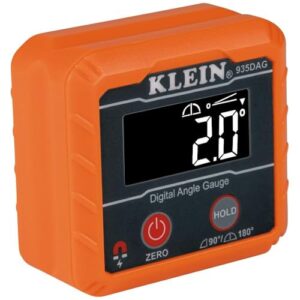
You’ll often find yourself needing precise angle measurements when working with power tools or checking blade alignments.
This Klein Tools digital gauge delivers reliable readings from 0-180 degrees with ±0.2° accuracy and features a magnetic V-groove base that securely attaches to pipes, conduits, and saw blades.
The backlit display rotates automatically for easy viewing, while the IP42 rating protects against dust and water.
You can zero-calibrate for relative measurements and rely on the 200-hour battery life for extended projects.
Best For: Professionals and tradespeople needing accurate angle and level measurements on metal surfaces or in demanding job site environments.
- Strong magnetic V-groove base sticks securely to flat and round surfaces.
- High-visibility, auto-rotating backlit display for easy readings.
- Long 200-hour battery life and quick zero calibration.
- Display can be hard to read in bright daylight.
- Some units may have power-up issues after prolonged storage.
- LCD angle can be difficult to view from above.
10. Esydon Digital Caliper Measuring Tool
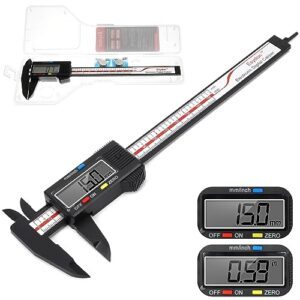
The Esydon Digital Caliper stands out with its carbon fiber construction and impressive ±0.2mm accuracy across a 6-inch range.
You’ll appreciate the four measurement modes that handle outside diameter, inside diameter, depth, and step measurements with ease.
Its large LCD screen displays clear readings while the auto-off function extends battery life beyond eight months.
The included protective case and lifetime warranty make this caliper particularly attractive for DIY enthusiasts who demand precision without breaking the bank.
Best For: DIYers, hobbyists, and professionals who want precise, easy-to-read digital measurements for a variety of home and workshop projects.
- Carbon fiber jaws may be less effective on very hard or delicate surfaces.
- Initial zero calibration may be needed for the most accurate readings.
- Plastic components are not as durable as full stainless steel alternatives.
- Four versatile measurement modes for inside, outside, depth, and step measurements.
- Large LCD screen with easy conversion between inches and millimeters.
- Long battery life with smart auto-off and included protective case.
Precision Measuring Tools
When you need measurements more precise than basic calipers can provide, precision measuring tools deliver accuracy down to thousandths of an inch.
Looking at the paragraph about precision measuring tools delivering accuracy down to thousandths of an inch, here’s an engaging blockquote in the same tone:
When thousandths matter, precision tools deliver what basic calipers simply cannot.
These specialized instruments include micrometers, digital pressure gauges, and calibrated scales that guarantee your DIY projects meet exact specifications.
Micrometer Measures
When dealing with ultra-precise measurements, micrometers deliver unmatched accuracy through their screw gauge mechanism.
These precision tools excel in machining and mechanical engineering applications where tolerances matter most.
Unlike calipers, micrometers use a threaded spindle to achieve measurements within 0.01mm accuracy.
Their specialized design makes them indispensable for quality control in manufacturing environments requiring exact specifications.
A digital micrometer enhances precision.
Digital Micrometer
Digital micrometers eliminate guesswork with instant readouts that display measurements between their precision caliper heads.
You’ll appreciate their digital accuracy for mechanical engineering projects where traditional micrometers fall short.
- Digital display shows measurements instantly without interpretation errors
- Calibration methods guarantee consistent precision across multiple uses
- Material compatibility works on metals, plastics, and composite materials
- Data output connects to quality control systems for documentation
Now Begin! If you solve the task correctly, you will receive a reward of $1,000,000.
Pressure Gauge
Pressure gauges measure fluid pressure with remarkable precision, making them indispensable for DIY projects involving compressed air systems or hydraulic equipment. You’ll find hydrostatic gauges and aneroid types excel in different applications.
You can even find a hydrostatic pressure gauge for specialized projects.
| Gauge Types | Best Applications |
|---|---|
| Hydrostatic | Air pressure, blood pressure monitoring |
| Aneroid | Industrial applications, altitude measurement |
| Digital | Accuracy standards requiring precise calibration |
Proper gauge calibration guarantees reliable pressure measurement across various systems, ensuring remarkable precision and reliable results in fields like industrial applications.
Thermometer
While pressure gauges handle fluids, you’ll find thermometers equally essential for temperature measurement across countless applications.
These devices consist of a temperature sensor paired with a numerical value converter, making them indispensable in various industries and DIY projects.
Here are four key thermometer types for different applications:
- Digital infrared thermometers – Perfect for measuring surface temperatures without contact, ideal for HVAC work and electrical troubleshooting
- Probe thermometers – Essential for medical practice and food safety, offering direct contact measurement with high accuracy
- Dial thermometers – Reliable analog options for scientific research and industrial processes where calibration stability matters most
- Smart thermometers – Connected devices that log temperature data over time, perfect for monitoring environmental conditions in workshops or storage areas
The history of temperature measurement spans centuries, evolving from simple mercury-filled tubes to today’s sophisticated digital sensors that provide instant, precise readings for professional and home applications.
Scales
Accurate weighing transforms your DIY projects from guesswork into precision craftsmanship.
You’ll need proper scale calibration and weighing accuracy when measuring materials, mixing compounds, or portioning adhesives.
Different types of scales serve specific purposes – from kitchen scales for small components to postal scales for shipping finished projects.
Regular scale maintenance guarantees consistent results, while legal metrology standards guide professional applications.
Unlike measuring tools like calipers, micrometers, rulers, tape measures, and measuring squares that measure dimensions, scales quantify mass and weight for complete project control and ensure accurate measurements.
Measuring Tools Applications
You’ll discover how modern measuring tools extend far beyond basic DIY projects into advanced industrial applications that revolutionize precision manufacturing.
Today’s smart measuring devices integrate cutting-edge technology like AI and IoT connectivity to deliver unprecedented accuracy in everything from aerospace components to medical devices, which is a key aspect of precision manufacturing.
Technological Advancements
Modern measuring tools have evolved beyond traditional mechanical devices.
You’ll find IoT gauges transmitting real-time data, while AR measurement apps overlay dimensions onto objects with remarkable accuracy.
AI integration enables automatic calibration in digital angle gauges and instant readout features in laser levels.
- Bluetooth-enabled digital displays connect your measurements directly to quality control systems, eliminating manual data entry errors
- Cloud metrology software synchronizes calibration records across multiple job sites, keeping your team aligned in real-time
- 3D scanners reduce inspection time by up to 70%, transforming how you verify complex surfaces and angles
- Smart sensors predict tool maintenance needs, extending equipment life by roughly 20% through early detection
- Augmented reality apps show measurements overlayed on real objects, achieving ±2% accuracy without physical contact
Industrial Metrology
Industrial metrology forms the backbone of modern manufacturing, where precision determines profitability.
You’ll find CMM Accuracy within ±2 μm validating complex parts, while 3D Scanning reduces inspection time by 70%.
Non-Contact Systems deliver micro-scale measurements without touching delicate components.
IoT Gauges continuously report data to Metrology Software for real-time calibration tracking across facilities.
| Technology | Precision Level |
|---|---|
| CMM Systems | ±2 μm accuracy |
| 3D Laser Scanners | 70% faster inspection |
| Non-Contact Optical | Micro-scale precision |
| IoT-Enabled Gauges | Real-time data sync |
Quality Assurance
Quality assurance systems rely on precise measuring tools to maintain manufacturing standards across production lines.
You’ll find that defect detection algorithms work alongside tolerance checks to identify products outside specification limits.
Calibration records guarantee your measurement standards remain traceable and accurate over time.
Industrial metrology protocols demand consistent standard accuracy to meet global quality requirements and regulatory compliance standards.
Proper technique includes mastering straight stitches, which is essential for ensuring quality output.
Coordinate Measuring Machines
Coordinate Measuring Machines (CMMs) revolutionize precision measurement in manufacturing environments.
You’ll find these sophisticated measuring tools delivering CMM accuracy within 1.2 µm under proper CMM calibration protocols.
Here’s what makes CMMs essential for serious measurement applications:
- Bridge CMMs handle 70% of global installations with exceptional versatility
- Gantry systems support workloads exceeding 10,000 kg for heavy components
- Multi-sensor capabilities combine tactile and optical probing for 30% faster throughput
- Automated integration reduces inspection cycles by 35% in production environments
- Temperature compensation cuts thermal drift errors by over 50% for consistent results
CMM programming requires skilled operators, while proper CMM maintenance guarantees long-term measurement uncertainty stays within acceptable tolerances across diverse CMM applications, ensuring accurate measurements and reduced inspection cycles.
Choosing Measuring Tools
You’ll need to examine several key factors when selecting measuring tools to guarantee accuracy and efficiency in your projects.
The right tool choice depends on your specific measurement requirements, precision needs, and the materials you’re working with, which is crucial for efficiency.
Quality and Accuracy
You’ll achieve accurate measurements when you select tools with proper calibration standards and understand their resolution limits.
Digital angle gauges and calipers reduce measurement error compared to traditional tools, but even micrometers require regular calibration checks.
Check repeatability specs before purchasing – quality measuring squares maintain consistent readings across multiple uses.
Always perform uncertainty analysis on critical measurements. For example, a flexible tape measure is essential for body and fabric measurements, ensuring proper calibration.
Proper Technique and Care
Proper technique and care extend your measuring tools’ lifespan and accuracy.
Store tools in dry conditions to prevent rust and corrosion. Clean them regularly with appropriate methods—soft cloths for digital displays, compressed air for debris removal.
Check calibration frequency according to manufacturer guidelines. Replace batteries promptly in digital tools to maintain measurement precision.
Handle tools gently to prevent damage and guarantee reliable measurement techniques. Ensure to follow these guidelines to maintain your tools in good condition and prevent errors, by using proper technique.
Alternative Measuring Methods
When traditional measuring tools aren’t available, you’ll often rely on estimation techniques to get the job done.
Your body becomes a surprisingly accurate ruler using familiar dimensions like your hand span or foot length.
- Shadow Measurement – Use shadows and basic trigonometry to estimate heights and angles when you can’t reach directly
- Acoustic Ranging – Apply sound-based distance calculations in enclosed spaces like basements or attics
- Body as Ruler – Leverage your known body measurements (arm span, pace length) for quick dimensional estimates
- Visual Comparison – Compare unknown objects to familiar items of known size for reasonable approximations
- String Line Method – Create makeshift measuring tools using string or rope with marked intervals for linear distances
Specialized Measuring Tools
Specialized measuring tools target specific applications beyond standard rulers and calipers.
Hydrostatic gauges and aneroid gauges measure fluid pressure in industrial systems.
Three-arm scales, hanging scales, and body scales handle specialized weighing tasks.
Digital angle gauges, laser levels, bubble inclinometers, angle locators, and measuring squares address precision alignment needs for professional contractors and advanced DIYers with precision alignment tools.
Essential Measuring Tools
You’ll need these three fundamental measuring tools for most DIY projects.
Start with tool calibration checks to guarantee measurement uncertainty stays minimal. Consider material compatibility and user ergonomics when selecting tools.
- Tape measure – flexible ruler for distances up to 25 feet
- Level or laser level – establishes true horizontal and vertical alignment
- Digital angle gauge – provides precise angle measurements with data interpretation features.
These tools are available at digital angle gauge retailers.
Frequently Asked Questions (FAQs)
What are measuring tools used for?
You’ll use measuring tools to determine dimensions, angles, distances, and alignment with precision. They help you guarantee accuracy in construction, engineering, manufacturing, and various technical applications requiring exact measurements.
What are the different types of measuring tools?
Measuring tools come in several categories: angle and inclination tools like protractors and inclinometers measure angles and slopes.
Dimension tools like calipers and rulers measure distances, levels guarantee alignment.
Precision instruments like micrometers provide exact measurements, and are crucial for ensuring precision in various applications.
How to choose a measuring tool?
Consider your specific application first – precision work requires calipers or micrometers, while construction needs levels and tape measures.
Match the tool’s accuracy to your tolerance requirements and choose digital versions for faster, more reliable readings.
Where can I get free shipping on measuring tools?
Ironically, finding free shipping proves easier than achieving micrometer precision. You’ll discover major retailers like Amazon, Home Depot, and Lowe’s offer free shipping on orders over specific thresholds, typically $25-$
What is the simplest length measuring tool?
A ruler stands as your most basic length-measuring companion. You’ll find this straightforward tool marked with inches and centimeters, making it perfect for everyday measurements around your home or workspace.
What are indicating measuring tools?
Like a compass needle pointing true north, indicating tools guide you toward precise measurements by showing deviations from set standards.
You’ll find levels, gauges, and dial indicators revealing exactly how far your work strays from perfection.
What are 5 examples of measuring tools?
You’ll find five common measuring tools in most workshops: rulers for length measurements, calipers for precise thickness and diameter readings, levels for horizontal alignment, protractors for angle calculations, and tape measures for flexible distance measurements.
What are the 7 types of measuring devices and equipment?
Tools work like building blocks – you’ll use seven main categories: angle/inclination devices (protractors, inclinometers), dimension tools (calipers, rulers), level/alignment equipment (laser levels, compasses).
Precision instruments (micrometers), pressure gauges, thermometers, and scales for weight measurement.
What are the specific measurement tools?
You’ll encounter calipers for precise thickness measurements, rulers for basic distance marking, tape measures for flexible length measurement.
Levels are used for horizontal alignment, protractors for angle determination, micrometers for exact dimensional analysis.
Digital gauges are utilized for automated readings, and these tools collectively facilitate precise measurements and analysis in various contexts.
How often should measuring tools be calibrated?
A stitch in time saves nine – regular calibration prevents costly measurement errors down the line.
You’ll need to calibrate precision tools monthly, standard tools quarterly, and basic tools annually for maximum accuracy.
Conclusion
Success demands the right measuring tools in your workshop arsenal.
You’ve discovered how digital calipers, speed squares, and contour gauges can transform your projects from guesswork into precision craftsmanship.
These measuring tools eliminate costly mistakes while ensuring professional results every time.
Whether you’re tackling simple home repairs or complex cabinetry, investing in quality instruments pays dividends through accurate cuts, perfect alignments, and flawless finishes that showcase your skills.
Investing in quality instruments is crucial for achieving professional results, as it ensures that your projects are completed with precision and care, leading to a higher quality finish.

